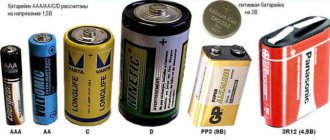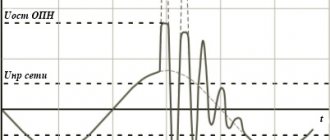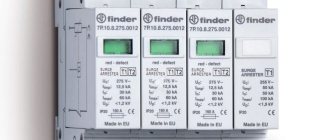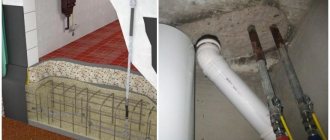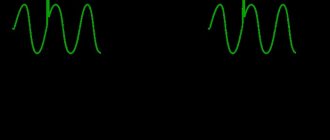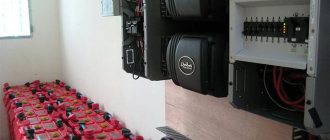It is understood that when the power cord of the device is plugged into the outlet, the voltage in it corresponds to the nominal value, which is known in advance. In an apartment we are usually talking about 230 V. There are 380 V sockets that are used for more powerful equipment. In practice, this happens in the vast majority of cases, but not always. If random failures occur in the electrical network, the voltage may significantly exceed the nominal value. Regulatory documents require that the voltage is guaranteed to deviate by no more than 10%. For 230 V, this range is 207–253 V. Overvoltage protection allows you to prevent problems with the equipment in use in the event of an emergency.
Causes and danger of power surges
When there is a voltage drop in electrical networks, its amplitude changes for a short period of time. After this, it is quickly restored with parameters close to the initial level.
Such an electric current impulse lasts literally for several milliseconds, and its occurrence is due to the following reasons:
- Lightning discharges. They cause voltage surges of up to several kilovolts, which no device can withstand. Such fluctuations often cause network outages and fires.
- Overvoltage caused by switching processes when high power consumers are connected or disconnected.
- The phenomenon of electrostatic induction when connecting electric welding, commutator motors and other similar equipment.
The danger of consequences from overvoltages is clearly reflected in the figure, where lightning and switching impulses differ significantly from the rated mains voltage. The insulating layer in most wires is designed to withstand significant differences and breakdowns usually do not occur. Often the pulse does not last long and the voltage, passing through the power supply and stabilizer, simply does not have time to rise to a critical level.
Sometimes the insulation layer of a 220 V network may not withstand the increasing voltage. As a result, a breakdown occurs, accompanied by the appearance of an electric arc. For the flow of electrons, a free path is formed in the form of microcracks, and gases filling the microscopic voids serve as a conductor. This process is accompanied by the release of a large amount of heat, under the influence of which the conductive channel expands even more. Due to the gradual increase in current, the operation of the automatic protective equipment is slightly delayed, and these few moments are enough to damage all the electrical wiring in a private house.
Particularly dangerous are high and low voltages that remain in this state for a long time. This mainly happens due to emergency situations that need to be eliminated in order for the current to return to normal. There are no other methods of normalization or any special devices that protect against this phenomenon.
Connection options
One of the most important questions is how to connect the SPD in the panel. Almost all connection options are identical and are indicated in the technical data sheet of the product. Methods for installing protection devices may differ, depending on where they will be installed, in a single-phase or three-phase network, and also depending on the grounding system.
The most modern and meeting all safety requirements is the tn-s grounding system, in which the neutral working (N) and neutral protective (PE) wires operate separately throughout the entire power supply system. The tn-cs system represents a combined option, in which N and PE from the power source to the ASU of the house are combined into one wire, after which the separation of the neutral and protective conductor begins. It should be remembered that this circuit will not work without grounding, so it is necessary to arrange it. The tn-c system is the simplest and most common grounding system in outdated housing, in which the role of the neutral and working conductors is performed by one wire (PEN).
The diagram below shows how to connect a class II surge protector in a single-phase network installed in the panel of an apartment or private house with two options for the grounding system. For this connection option, it is necessary to select the simplest single-block protective device with the appropriate operating voltage.
Connection diagram with tn-c grounding system:
If a tn-s grounding system is provided, in this case it will be necessary to install and connect an SPD consisting of two modules, the design of which provides separate terminals for connecting the phase, neutral working and protective wires, marked accordingly.
The connection of the SPD in a three-phase network is carried out as shown in the photo:
When installing an SPD, it is necessary to provide means for protecting the network in the event of a short circuit in the device and connect it through a circuit breaker or through a fuse. The device can be installed before or after the meter; in the second case, the electricity meter will remain unprotected from surge voltage.
The video below clearly demonstrates how to connect this device in the panel:
So we looked at how the SPD should be connected to the panel. We hope that the provided diagram, video and photo examples were useful to you and helped you understand how to connect this protective device.
It will be useful to read:
- How to make grounding in a house
- Why do you need an RCD in an apartment?
- How to make a lightning rod with your own hands
- Voltage relay connection diagrams
Types and principle of operation of protective devices
Protecting the electrical network from power surges can be done in different ways. The most common and effective are the following:
- Lightning protection systems.
- Surge Protectors.
- Overvoltage sensors used in conjunction with RCDs. In the event of a malfunction, they cause a current leakage, under the influence of which the protective device will operate.
- Overvoltage relay.
Similar functions are performed by uninterruptible power supplies, with the help of which computers are connected to the home network. These devices do not protect against overvoltage; they act like batteries, allowing you to shut down the computer normally and save the necessary information in the event of a sudden power outage. This device cannot stabilize the voltage.
Electrical impulses are generated by lightning. Protection from their negative impact is carried out by installing a lightning arrester used in conjunction with an SPD - a surge protection device. It is also known as surge protector. In addition, it is necessary to provide additional security against electronic flow with parameters that differ from the operating characteristics of a given network. For these purposes, special sensors used with RCDs and overvoltage protection relays are used. The purpose and principle of operation of these devices is not the same as that of a stabilizer.
The main function of both components is to stop the supply of electric current when the voltage drop exceeds the maximum value determined by the technical specifications of these devices. After the network parameters are normalized, the relay turns on independently and resumes the current supply.
SPD classification
Surge voltage protection devices are a broad and general concept. This category of devices includes devices that can be divided into classes:
- I class. Designed to protect against direct exposure to lightning. These devices must be equipped with input distribution devices (IDUs) of administrative and industrial buildings and residential apartment buildings.
- II class. They provide protection of electrical distribution networks from overvoltages caused by switching processes, as well as performing the functions of the second stage of protection against lightning strikes. Mounted and connected to the network in distribution boards.
- III class. They are used to protect equipment from surges caused by residual voltage surges and asymmetrical voltage distribution between the phase and the neutral wire. Devices of this class also operate in high-frequency interference filter mode. They are most relevant for the conditions of a private house or apartment; they are connected and installed directly at consumers’ premises. Particularly popular are devices that are manufactured as modules equipped with a quick-release mount for installation on a DIN rail, or have a configuration of electrical sockets or network plugs.
Surge suppressors
When considering issues of network overvoltage protection, it should be noted that this function should primarily be performed by organizations responsible for power supply. They are the ones who install the necessary protective devices on power lines. However, as practice shows, this is not always done, and consumers themselves are forced to solve the problem of protecting their home from overvoltage.
Protection against overvoltage in the network at substations and overhead power lines is carried out using surge arresters - nonlinear surge suppressors. The main component of these devices is a varistor, which has nonlinear characteristics. Its nonlinearity consists in the changing resistance of the element in accordance with the magnitude of the applied voltage.
When the electrical network is operating in normal mode, and the voltage is at its nominal value, the voltage limiter at this time has a large resistance that prevents the passage of current. If, during a lightning strike, an overvoltage pulse occurs, a sharp decrease in the resistance of the varistor occurs to a minimum value and all the energy of the pulse goes into the ground loop connected to the arrester. This ensures a safe voltage level and ensures that all equipment is reliably protected.
How to connect an SPD in a private house?
Protective devices can be connected to household electrical networks (with one phase and operating voltage 220V) and to current-carrying lines of industrial facilities (three phases, 380V).
Based on this, the complete SPD connection diagram provides for the effect of the corresponding voltage indicator. If the role of grounding and neutral conductor is played by a common cable, then in such a circuit a simple single-block SPD is installed. It is connected as follows: a phase conductor connected to the input of the protective device - an output cable connected to a common protective conductor - the protected electrical appliances and equipment.
In accordance with the requirements of modern electrical documentation, the neutral and grounding conductors should not be combined. Based on this, in new homes, to protect the circuit from voltage surges, a two-module device is used, which has three separate terminals: phase, neutral and ground.
In this case, the device is connected to the circuit according to a different principle: the phase and neutral cable go to the corresponding terminals of the SPD, and then in a loop to the equipment connected to the line. The grounding conductor is also connected to its terminal of the protective device.
In each of the cases described, the excessive current generated by the overvoltage flows into the ground through the ground cable or common protective conductor without affecting the line or the equipment connected to it.
Answers to questions about SPDs in the video:
Other types of protective devices
There are other options for protecting against network surges. They are widely used in everyday life and are considered one of the most effective means.
Network filters
They are distinguished by their simple design and affordable cost. Despite its low power, this device is quite capable of protecting equipment during surges reaching 380 volts and even 450 volts. The filter cannot withstand higher pulses. It simply burns out, keeping expensive electronics intact.
This surge protection device is equipped with a varistor, which plays a key role in providing protection. It is this that burns out at pulses above 450 V. In addition, the filter reliably protects against high-frequency interference that occurs during welding or electric motors. Another component is a fuse that trips during short circuits.
How does an SPD work?
SPD eliminates overvoltages:
- Asymmetrical (common-mode) mode: phase - ground and neutral - ground.
- Symmetrical (differential) mode: phase - phase or phase - neutral.
In single-ended mode, when the voltage exceeds a threshold value, the protection device discharges energy to ground. In symmetrical mode, the energy removed is directed to another active conductor.
SPD connection diagram in single-phase and three-phase networks of the TN-S system. The TN-C grounding system uses a three-pole SPD. It does not have a contact for connecting the neutral conductor.
SPD connection diagram in single-phase and three-phase networks of the TN-S system. The TN-C grounding system uses a three-pole SPD. It does not have a contact for connecting the neutral conductor
In arresters, when exposed to a lightning discharge as a result of overvoltage, an air gap breaks through the jumper connecting the phases to the ground loop, and a high voltage pulse goes into the ground. In valve-type arresters, the high-voltage pulse in a circuit with a spark gap is suppressed by a resistor.
SPDs based on gas-filled arresters are recommended for use in buildings with an external lightning protection system or supplied with electricity via overhead lines.
In varistor devices, the varistor is connected in parallel with the protected equipment. In the absence of pulse voltages, the current passing through the varistor is very small (close to zero), but as soon as an overvoltage occurs, the resistance of the varistor drops sharply, and it passes it through, dissipating the absorbed energy. This causes the voltage to drop to nominal and the varistor returns to non-conducting mode.
The SPD has built-in thermal protection, which provides protection against burnout at the end of its service life. But over time, after several trips, the varistor surge protection device becomes conductive. The indicator informs about the end of its service life. Some SPDs provide remote indication.
